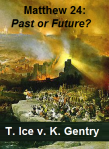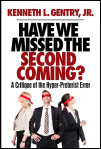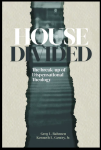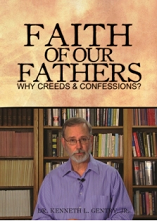INTRODUCING ISAIAH (3)
 PMW 2023-097 by Kenneth L. Gentry, Jr.
PMW 2023-097 by Kenneth L. Gentry, Jr.
This is my final article on the introduction to Isaiah. Please see previous two posating before reading this one.
SPECIAL ISSUES
One of the most hotly-debated issues in biblical studies concerns the authorship of Isaiah: was it written by one author or by several over a 100+ year period, only eventually being compiled as one book. Before the rise of modern biblical criticism, the unity of Isaiah was the historic position of Judaism and Christianity. Before the eighteenth century, only the twelfth century Jewish commentator Ibn Ezra (1089–1167 AD) questioned the book’s unity.
The beginning of modern criticism. In 1780 the French Old Testament scholar Jean Astruc began the modern critical movement in biblical studies. He started Pentateuchal criticism, arguing that Moses did not write Genesis but that it is an edited compilation derived largely from two main sources. This movement quickly began critical analysis of other books of Scripture challenging the longstanding, historic understanding of biblical authorship.
 Great Tribulation: Past or Future?
Great Tribulation: Past or Future?
(Thomas Ice v. Ken Gentry)
Debate book on the nature and timing of the great tribulation. Both sides thoroughly cover the evidence they deem necessary, then interact with each other.
See more study materials at: www.KennethGentry.com
By 1892 German biblical scholar Bernhard Duhm (1847–1928) was arguing that Isaiah was a compilation of prophecies from three authors: the actual prophet Isaiah wrote chapters 1–39, now called Proto-Isaiah by critics, in the eighth century BC. But some unknown prophet wrote Deutero-Isaiah, chapters 40–55, in the mid-sixth century BC. Then another unknown prophet, wrote Trito-Isaiah, chapters 56–66 sometime after the return from exile.
The argument for multiple authorship. Five of the leading critical arguments are:
First, Isaiah 44:28 and 45:1 expressly name the sixth-century Persian ruler Cyrus (559–530 BC). This is over 150 years before he comes on the historical scene, which detailed prophecy is deemed impossible by anti-supernaturalists.
Second, Isaiah 40–66 reads as if Jerusalem had already fallen and the Babylonian exile had already begun rather than its being predicted in advance. For instance, Isaiah 42:22: “But this is a people plundered and despoiled; / All of them are trapped in caves, / Or are hidden away in prisons; / They have become a prey with none to deliver them, / And a spoil, with none to say, ‘Give them back!’” And Isaiah 51:17: “Rouse yourself! Rouse yourself! Arise, O Jerusalem, / You who have drunk from the Lord’s hand the cup of His anger; / The chalice of reeling you have drained to the dregs.”
Have We Missed the Second Coming:
A Critique of the Hyper-preterist Error
by Ken Gentry
This book offers a brief introduction, summary, and critique of Hyper-preterism. Don’t let your church and Christian friends be blindfolded to this new error. To be forewarned is to be forearmed.
For more Christian educational materials: www.KennethGentry.com
Third, Isaiah 40–66 presents new ideas and words, moving in a different world of discourse from the earlier chapters. For instance, Second Isaiah’s audience is non-political, hearing no mention of involvement in foreign affairs or trust in men and horses. Fourth, these latter chapters are more impassioned and lyrical than the earlier chapters. Cities and nature are often personified and presented more dramatically. Fifth, the earlier section of Isaiah focused more on God’s majesty, whereas the latter chapters highlight his uniqueness as the only God.
A defense of unified authorship. Over against the critical arguments we may note: First, all ancient traditions recognized the antiquity and unity of Isaiah. Around 400 BC, 2 Chronicles 32:32 speaks of the book of Isaiah as existing at that time, without any assumption of its composite nature. In 200 BC the author of Ecclesiasticus (48:24–25) considered Isaiah as the author of the whole book. Around 150 BC the Qumran community already had several copies of the book, showing they accepted its integrity and from a much earlier period. And the first century A.D. New Testament clearly assumes one author for the whole of Isaiah. It cites from all sections of the book and attributes each to Isaiah. For example, see Isaiah 40:3 (Matt. 3:3); 53:4 (Matt. 8:17); 42:1 (Matt. 12:17); 6:9–10 (Matt. 13:14). It can even put verses from earlier and later sections of Isaiah in one passage, e.g., Isaiah 6:9–10 and 53:1 appear in John 12:38–39.
Second, there is no concrete evidence that any part of Isaiah existed separately from the rest, i.e., no Isaiah manuscripts separating the two or three sections, no discernible seams patching together the two or three parts, no ancient external statements from early writers. This should not be surprising in that the heading to the whole book states that it was written by Isaiah and covered four reigns (1:1) On the critic’s assumption, it is hard to explain how Isaiah came to exist as one book at all. Nor do we find in Isaiah any reference to another author, as we do in the case the Psalms (see headings of Psa. 42, 50, 72, 90) and Proverbs (e.g., Prov. 22:17; 25:1; 30:1-33; 31:1–9). We do, however, have sixteen internal references to “Isaiah,” with almost half of them specifying he is the “son of Amoz” (1:1; 2:1; 13:1; 20:2; 37:2, 21; 38:1).
Third, the critic’s position is subjective. Their methodology is rooted in an assumption rather than evidence. They hold as a rationalistic, anti-supernaturalistic postulate that predictive prophecy is impossible, spurring them to search for an alternative explanation.
For instance, their leading complaint is Isaiah’s prophesying the arising of king named “Cyrus” over 150 after Isaiah wrote (44:28; 45:1). But consider: (1) This effectively denies the existence of the self-revealing God of Scripture, which calls for a Christian apologetics response. Christian apologetics bases its truth claims on its worldview that explains all reality (including laws of logic, mathematics, morality, etc.) on the firm foundation of the self-contained, all-powerful, eternally-existent God of Scripture. Over against this worldview is the current secular worldview that is rooted in chance, establishing the rational world on the basis of ultimate irrationality. That is, it holds that a chance explosion from out of nothing produced material something, then this material something randomly gave rise to living something, then personality arose out of living things. And all of this serves as the foundation for the laws of science, mathematics, logic, and morality. The secular position is irrational through-and-through, and therefore subjective in the final analysis.
(2) Biblical prophets often based their challenges to Israel on their prophetic ability. Thus, any after-the-fact “prophecy” would be counter-productive, undermining their moral challenge to their hearers. This would make deceivers out of these great proponents of personal and social righteousness. (3) If we remove “Cyrus” from Isaiah’s prophecy in 44:26–28, it would wholly undercut his message. For God is emphasizing his ability to foretell future events by presenting Cyrus as an objective confirmation of his authority (cf. 41:26; 48:5; 42:8–9; 43:9, 12–13; 44:7–8).
Besides, (4) Isaiah does not engage in predictive prophecy only in Deutero-Isaiah (after ch. 39). For early in his book he names his son “Shear-jashub” (7:3), which means “a remnant shall return.” This is long before the Babylonian captivity, which is obviously before the return of the remnant from exile. Then in 39:5–7 he prophesies the destruction and exile of Judah by Babylon long before these occur. (5) In the chapters before Isaiah 40, we see a growing concern of the approaching exile (3:24–26; 5:5–6; 6:11–13; 24:11–12; 27:13; 32:13–18). Yet critics allow these as prophecies from Isaiah son of Amoz.
Fourth, the literary unity of Isaiah undermines multiple authorship over a long period. (1) We find verbal agreement between chapters 1–39 and chapter 40–66. Compare the following examples: 40:5 and 58:14 (cp. 1:20); 43:13 (cp. 14:27); 60:21 (cp. 29:23); etc. (2) Isaiah emphasizes holiness as a major unifying theme throughout his book (e.g., 1:4; 5:16; 8:14; 10:17; 17:17; 30:11; 37:23; 43:15; 45:11; 48:17). (3) There are major similarities between Isaianic sections: God is called “the Holy One” twelve times in Proto-Isaiah (1:4; 5:19; 10:17, 20; 12:6; etc.) and fourteen times in Deutero-Isaiah (40:25; 41:14, 16, 20; 43:3, 14, 15; 54:5; 60:9; etc.). This name for God is rare in the Old Testament, appearing only four times elsewhere (Psa. 71:22; 89:18; Jer. 50:29; 51:5). Forty-plus phrases first appearing in Proto-Isaiah appear later in Deutero and Trito-Isaiah: 14:27 (cp. 43:13); 28:5 (cp. 63:3); 34:8 (cp. 61:2); 35:10 (cp. 51:11); etc.
(4) Any slight differences between the sections can be easily explained by the fact that Isaiah wrote over a long period of time (cf. 1:1) and on diverse topics. The “higher” literary quality of Isaiah 40–66 could be expected as Isaiah develops his writing skills over time. After all, literary scholars can detect Shakespeare’s style changes in four periods of his works.
Fifth, though Deutero-Isaiah seems to presuppose that the exile is already in effect, this can be explained by the prophet adopting an ideal standpoint. That is, to make his prophecy more vivid, he is prophesying the future suffering of Israel by projecting himself and the people into that future. He even speaks thus in the early chapters that critics grant to Isaiah (e.g., 5:13; 6:11–13).
House Divided: The Break-up of Dispensational Theology By Greg Bahnsen and Ken Gentry
By Greg Bahnsen and Ken Gentry
This book presents and defends Christian Reconstruction theology, particularly theonomic ethics and postmillennial eschatology. It does to by responding to dispensationalism’s social and exegetical theology.
For more educational materials: www. KennethGentry.com
Historical problems plague the critical view. First, Deutero-Isaiah refers to Jerusalem and other locales in Judah as if they are still in existence (40:9). This is despite their destruction by the Babylonians that had supposedly already occurred (cf. 2 Kgs. 25:9–10; 2 Chron. 36:19; Neh. 1:3; Jer. 39:8; 52:14). Trito-Isaiah even speaks of the walls of Jerusalem as if they are still intact (62:6; cp. 2 Kgs. 25:10).
Second, there are no social or geographical references providing evidence of Israel being in Babylon in exile. This is quite different from Ezekiel, who did live during Babylon’s conquest and shows evidence of such (Eze. 1:1; 19:9; 24:2). The writer of Isaiah 40–66 gives evidence of being in Israel. For instance, he mentions trees that are native to Israel (e.g., cedar, cypress, oak (41:19; 44:14)
Third, all references to Israel’s sin of idolatry in Deutero and Trito-Isaiah (40:19; 41:7, 29; 42:17; 44:9ff, 25; 45:15ff; 46:6ff; 63:3ff; 66:3, 17) are of the pre-exilic type (cf. 1:13, 29; 2:8ff; 8:19). We know, however, that after Jerusalem’s capture and destruction by the Babylonians, Israel never again engaged in idolatry — as we can see from the post-exilic writings of Haggai, Zechariah, and Malachi. For instance, Malachi has a list of Israel’s sins, but idolatry is not named (cf. Mal. 2:11, 13–16; 3:5, 7–12, 13–15).
The critical view of three Isaiah’s is unreasonable. All scholars recognize the high and exalted lyrical beauty of Isaiah 40–66. As previously noted, critical scholars even argue that the brilliant style of these chapters is evidence of their being written by an author different from and superior to Isaiah, who wrote chapters 1–39. But we should note that the book does not even hint at any other author(s), as is the case in Proverbs, which mentions Agur (Prov. 30:1) and Lemuel (31:1).
In addition, how could such an erudite and compelling writer have totally disappeared from history and tradition without a trace? No one in antiquity even mentions such a writer. And why would such an exalted work (chs. 40–66) be added as an appendix to a lesser Palestinian production (chs. 1–39)? If any other authors were involved, we must also wonder what led the editor(s) of Isaiah to be so definite about Isaiah’s identity as “the son of Amoz” (1:1)?
Click on the following images for more information on these studies:



Kenneth L. Gentry Jr.'s Blog
- Kenneth L. Gentry Jr.'s profile
- 85 followers



